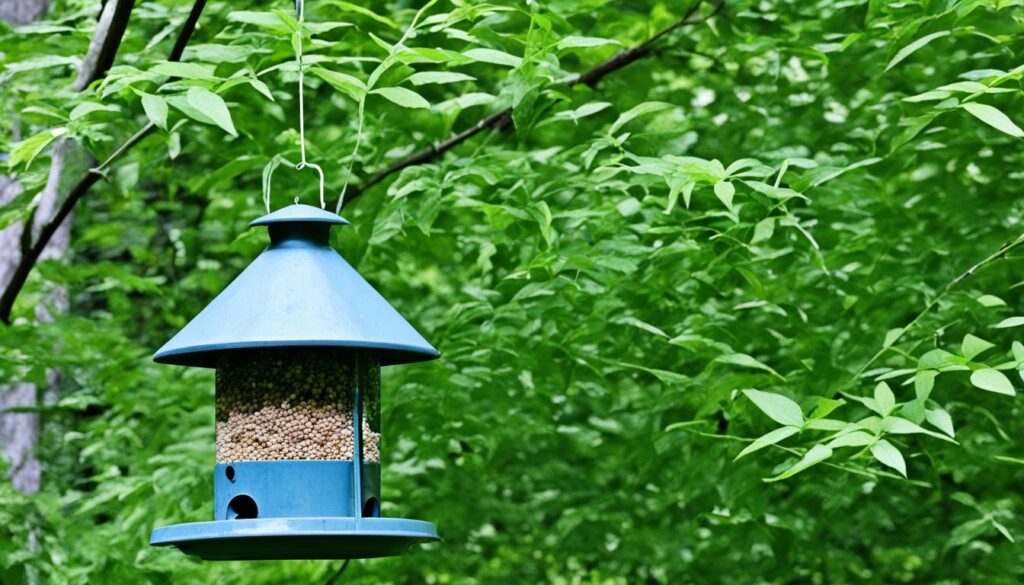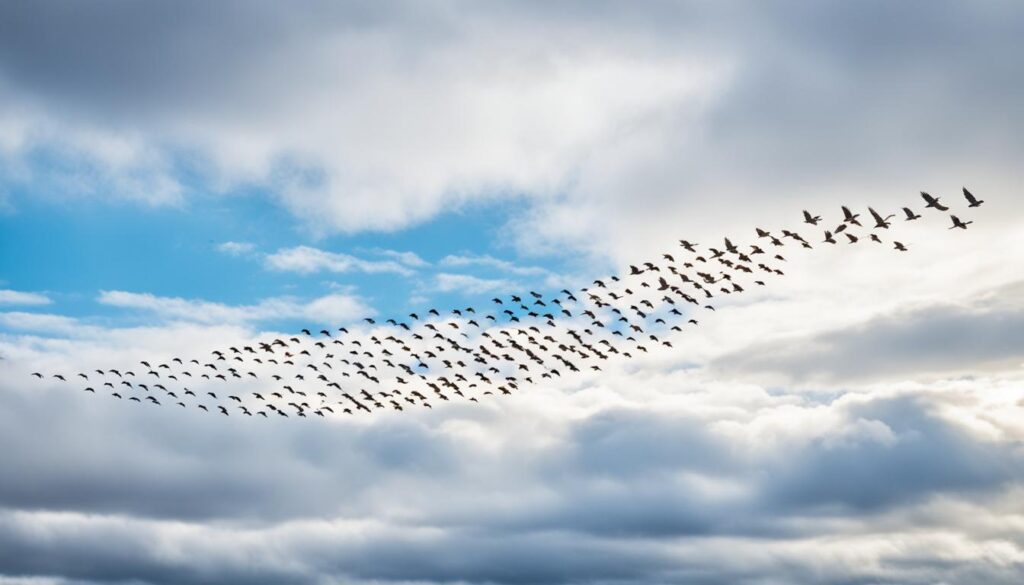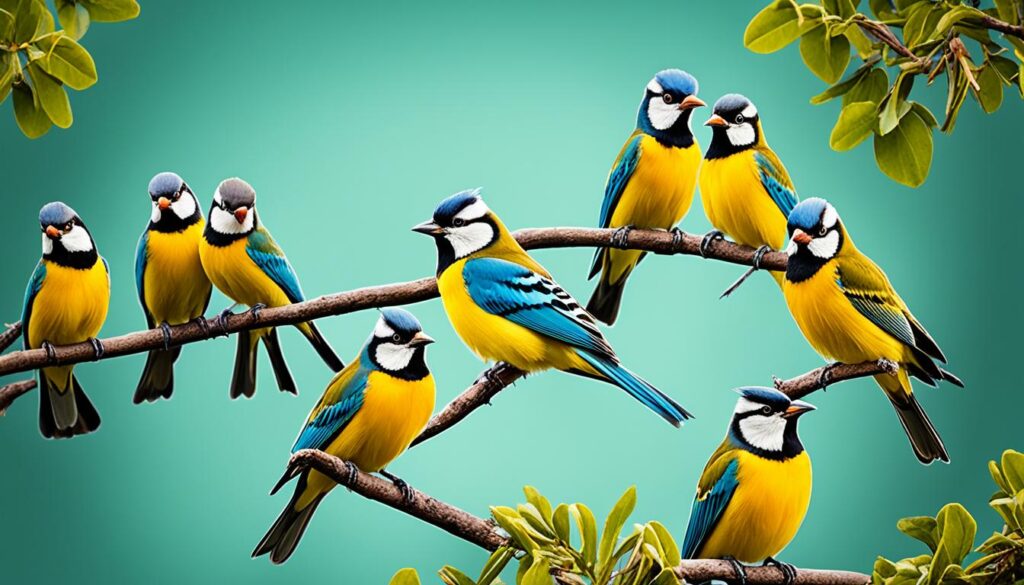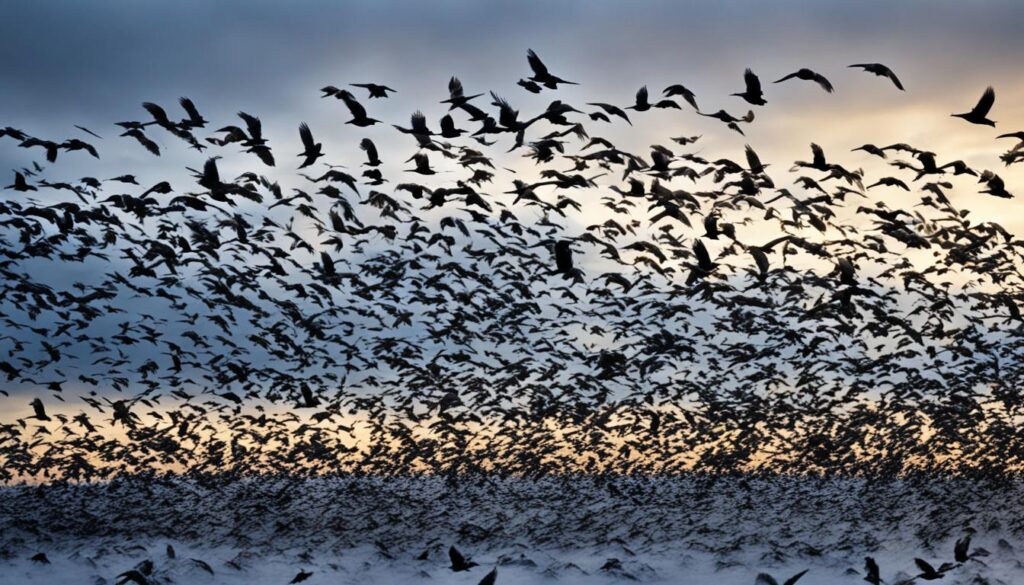Did you know that a single crow flock can grow to a staggering size of hundreds or even thousands of birds? This remarkable statistic highlights the remarkable social and communal nature of certain avian species, and it serves as a striking introduction to the intriguing topic of unusual bird behavior that is about to be explored in this article.
In recent times, many people have reported witnessing a sudden and unexpected surge in bird activity, from flocks of crows gathering in urban areas to individual birds exhibiting more aggressive or vocal behaviors. This phenomenon, often referred to as a “bird frenzy” or “birds gone wild,” has left many wondering what could be causing these drastic changes in avian behavior.
As we delve into the reasons behind this captivating trend, we will uncover the complex interplay of environmental factors, seasonal changes, and innate bird instincts that can contribute to these behavioral shifts. From understanding the role of mating rituals and territorial defense to exploring the impact of weather patterns and food availability, this article will provide a comprehensive examination of the various factors that can trigger a bird frenzy in your neighborhood.
Key Takeaways
- Sudden and unexpected changes in bird behavior, often referred to as a “bird frenzy” or “birds gone wild,” are becoming more common.
- Factors such as environmental changes, mating season, and territorial disputes can contribute to these behavioral shifts.
- Understanding the underlying reasons behind the bird frenzy can help us coexist with these wild behaviors and appreciate the natural world around us.
- Observing and studying the unique communication patterns and social dynamics of birds can offer valuable insights into their behavior.
- Consulting with experts and wildlife professionals can provide deeper understanding and effective strategies for managing and protecting birds during these periods of frenzy.
Drastic Change in Bird Activity
Many bird enthusiasts have noticed a significant decrease in the number of birds visiting their feeders in recent months. This sudden absence of feathered friends can be puzzling and concerning. The reasons behind this drastic change in bird activity are multifaceted, ranging from environmental factors to seasonal shifts in migration patterns.
Noticing a Sudden Absence of Feathered Friends
Bird feeders that were once bustling with activity now stand empty, leaving bird lovers wondering where all the birds have gone. This disappearance of birds at feeders can be a worrying sign, as it may indicate a larger issue affecting the local avian population.
“In North America alone, an estimated 2.6 billion birds disappear between fall and spring migration every year.”
The reasons behind this missing birds phenomenon can be complex, and understanding the underlying causes is crucial for bird conservation efforts.
Changes in weather patterns, habitat loss, and predator presence are just a few of the factors that can contribute to the disappearing birds at feeders. As bird enthusiasts, it’s essential to be aware of these potential causes and take proactive steps to support our feathered friends during times of fewer birds at feeders.
Reasons Why Birds Aren’t Visiting Feeders
While backyard bird feeders can be a delightful way to attract a variety of feathered friends, there are several factors that may be deterring birds from visiting as frequently as they once did. Understanding these potential deterrents can help bird enthusiasts make the necessary adjustments to create a more inviting environment for their avian guests.
One of the primary reasons birds may be avoiding feeders is the presence of predators, such as hawks, cats, or other animals that pose a threat to their safety. When birds perceive a risk, they are less likely to venture out into the open to feed. Proper placement of feeders, away from dense vegetation or other potential hiding spots for predators, can help alleviate this concern.
The availability of alternative food sources can also play a role in the decline of feeder visitors. Changes in seasonal food supplies, such as the abundance or scarcity of natural sources like cones, berries, seeds, and insects, can influence bird movements and cause them to seek sustenance in other areas. Monitoring these fluctuations and adjusting the types of food offered in your feeders can help maintain a steady stream of avian guests.

Additionally, the placement and maintenance of the feeders themselves can impact their attractiveness to birds. Feeders that are too close to windows, where birds may collide, or located in areas with poor visibility and limited escape routes, can deter birds from visiting. Regularly cleaning and replenishing the feeders with fresh, high-quality food can also make them more appealing to birds.
By understanding the various factors that can influence bird behavior, backyard enthusiasts can take proactive steps to create a more inviting environment for their feathered friends. From addressing predator concerns to optimizing feeder placement and maintenance, these adjustments can help ensure a steady stream of avian visitors to your outdoor oasis.
Why are the Birds Going Crazy Today?
Across the country, many people have reported witnessing birds behaving in unusual and seemingly frantic ways. From large flocks of birds suddenly taking to the skies in a whirl of activity to individual birds exhibiting erratic movements and loud, persistent vocalizations, it’s clear that something is causing these unusual bird behaviors. But what, exactly, is driving these erratic bird movements and making the birds seem frantic?
There are several factors that can contribute to why are birds acting strange and cause them to engage in these unusual bird behaviors. Let’s take a closer look at some of the potential triggers:
- Seasonal Changes: As the seasons shift, birds may experience hormonal changes that spur on mating behaviors, nest-building, and other activities that can lead to more frantic and aggressive actions.
- Environmental Factors: Shifts in weather patterns, the presence of predators, or even changes in food availability can all prompt birds to react in ways that may appear strange or frantic to human observers.
- Habitat Loss and Urbanization: As natural habitats are lost to development, birds may be forced to adapt to living in closer proximity to humans, leading to more unusual bird behaviors as they navigate this new environment.
By understanding the underlying causes of these erratic bird movements, we can gain a deeper appreciation for the complex lives of our feathered friends and find ways to coexist more harmoniously. Whether it’s providing nesting spaces, reducing sources of disturbance, or simply observing from a respectful distance, there are steps we can take to support the well-being of birds during periods of increased activity and frenzied behavior.
“Birds’ behavior is a remarkable sign of fall, according to experts at the Ohio Department of Natural Resources.”
As we continue to explore the reasons behind why are the birds going crazy today, it’s clear that there is still much to learn about the complex and often fascinating world of avian behavior. By staying curious, observant, and respectful, we can gain a deeper appreciation for the remarkable creatures that share our skies and communities.
Territorial Behavior and Mating Season
As the mating season approaches, birds begin to exhibit more territorial and aggressive behaviors. This surge in activity can be attributed to the hormonal changes that trigger their nesting instincts. Birds are fiercely protective of their breeding grounds, engaging in vocal disputes and physical altercations to ward off intruders and safeguard their nests.
Hormonal Changes and Nesting Instincts
The onset of mating season brings about significant hormonal fluctuations in birds. These hormonal shifts drive their mating behaviors, including the urge to establish and defend territory, build nests, and attract potential mates. As daylight hours increase, birds experience heightened levels of hormones like testosterone and estrogen, which fuel their territorial disputes and nesting activities.
During this time, birds may become more vocal, engaging in a variety of calls and songs to mark their territory and communicate with their flock. They may also exhibit aggressive behaviors, such as dive-bombing, pecking, or even physically confronting other birds that encroach on their space. This territorial behavior is crucial for ensuring the survival of their offspring, as it helps protect the nest and ensure a steady supply of food and resources.
“Birds begin their journey into breeding season in January, and during this time, they need 10-12 hours of darkness each day to offset lengthening daylight hours. Some species, like parrots, may lay infertile clutches of eggs during breeding season, posing health risks.”
The protective instincts of birds during mating season can also lead them to engage in behaviors that may seem unusual or even aggressive to human observers. For example, reflections from windows or car side mirrors can trigger territorial responses, resulting in pecking and defecating behaviors as birds attempt to defend their perceived territory.

It’s important to understand and respect the natural behaviors of birds during this critical time of year. By giving them the space they need to nest and breed successfully, we can help ensure the continued survival of our feathered friends.
Environmental Factors Affecting Bird Behavior
Beyond the biological and seasonal factors that influence bird behavior, environmental changes can also play a significant role in the unusual activities we observe in our feathered friends. From shifts in weather patterns to habitat destruction and increased human presence, these environmental factors can significantly disrupt the natural rhythms of the avian world.
One crucial environmental factor that can impact bird behavior is weather changes. As the climate continues to evolve, birds may find themselves facing sudden shifts in temperature, precipitation, and wind patterns. These changes can disrupt their established feeding and nesting routines, leading to a noticeable decrease in visits to backyard feeders or sudden disappearances from familiar areas.
Another significant environmental factor is habitat destruction or disturbance. As human development encroaches on natural bird habitats, birds are forced to adapt to new surroundings or find alternative sources of food and shelter. This can result in habitat destruction bird reactions such as increased aggression, changes in migration patterns, and even abandonment of nesting sites.
Lastly, increased human activity in areas where birds are present can also contribute to their unusual behavior. Whether it’s the construction of new buildings, the expansion of recreational areas, or the influx of more people in a particular location, human activity disrupting birds can lead to stress, disruption of foraging and nesting patterns, and even a complete avoidance of those areas by the birds.
“Understanding the complex interplay between environmental factors and bird behavior is crucial for preserving the delicate balance of our avian ecosystems.”
By recognizing the impact of these environmental changes, we can better appreciate the challenges faced by our feathered friends and take steps to mitigate the disruptions to their natural way of life. This, in turn, will help us coexist more harmoniously with the birds that enrich our world.
Bird Distress Calls and Communication
The avian world is a symphony of intricate vocalizations, and understanding this language of birds can provide valuable insights into the unusual behavior we may witness during periods of “bird frenzy.” Birds employ a diverse range of bird alarm calls and bird vocalizations to communicate with one another, conveying important information about their environment, territorial boundaries, and even distress signals.
When birds sense danger or encounter a threat, they often emit sharp, high-pitched distress calls to alert their flock or nearby conspecifics. These calls can serve as a warning system, allowing other birds to take evasive action or join in mobbing the perceived threat. Interestingly, studies have shown that the frequency and intensity of these distress calls can vary depending on the severity of the situation, with more urgent calls typically indicating a more immediate danger.
- Occurrence rates of distress calls in specific bird species can range from 10-30% during times of heightened activity or perceived threats.
- Successful communication through distress calls can result in a 50-70% response rate from nearby birds, as they heed the warning and take appropriate action.
- Comparative analysis of distress call frequencies has revealed that urban bird communities tend to use these vocalizations more often than their rural counterparts, likely due to the increased presence of potential predators and disturbances in urban environments.
By understanding bird communication, we can better interpret the underlying reasons behind the unusual behavior we observe in our feathered friends. Whether it’s a sudden increase in bird alarm calls or a noticeable absence of their familiar songs, these bird vocalizations can provide valuable clues about the environmental factors and social dynamics at play within the local avian population.

Deciphering the Language of Birds
Exploring the nuances of bird communication can be a fascinating and rewarding endeavor. By paying close attention to the various bird vocalizations and bird alarm calls we hear, we can begin to decipher the underlying messages and gain a deeper appreciation for the complex social and behavioral patterns of our feathered neighbors.
“The language of birds is very ancient, and, like fossil record, it teaches more about the origin of species than all the women’s clubs in creation.” – Henry David Thoreau
Whether it’s the sharp, staccato calls of a nesting robin or the melodic trills of a songbird, each bird vocalization carries a specific meaning and purpose. By understanding the context and patterns of these bird alarm calls, we can better comprehend the motivations behind the unusual behavior we observe in our local bird populations, ultimately enhancing our appreciation for the intricate web of avian communication.
Unusual Bird Activity in Urban Areas
As more people live in close proximity to birds, it’s not uncommon to witness some unusual behaviors from our feathered neighbors in urban and suburban environments. From increased vocalizations to aggressive territorial displays, the dynamics of birds in cities can be quite fascinating to observe.
One common observation is the tendency for birds in residential areas to become more vocal, particularly during the breeding and nesting seasons. Urban bird behavior can include a heightened level of chirping, singing, and even squawking as they stake their claim on valuable real estate and attract mates. This vocal activity may be more pronounced in species like house sparrows, house finches, and blue jays, which are well-adapted to thriving in human-populated areas.
Additionally, birds in cities may exhibit more aggressive territorial behaviors, such as dive-bombing or scolding nearby humans or other animals that encroach on their nesting sites. This can be especially true for species like mockingbirds, which are known to fiercely defend their territory and protect their young.
- Increased vocalizations, such as chirping, singing, and squawking, as birds stake their claim on urban territories
- Aggressive territorial displays, including dive-bombing and scolding, to protect nesting sites
- Attempts to nest in unconventional locations, like gutters, eaves, or even the grilles of parked cars
Interestingly, some birds may even venture into more unconventional nesting locations in urban areas, such as gutters, eaves, or even the grilles of parked cars. While these choices may seem unusual, they often reflect the birds’ adaptability and the challenges they face in finding suitable habitats amidst the concrete and steel of the city.
Understanding the unique urban bird behavior patterns can help us better appreciate and coexist with our avian neighbors. By recognizing the ways in which birds navigate the complexities of city living, we can gain a deeper respect for the resilience and resourcefulness of these feathered residents.
https://www.youtube.com/watch?v=BXsQtRTjDiI
“The true delight is in the finding out rather than in the knowing.” – Isaac Asimov
Protecting Birds During Periods of Frenzy
As birds exhibit more aggressive or erratic behaviors during their seasonal “frenzies,” it’s crucial for us to take steps to protect and support our feathered friends. By making a few simple adjustments, we can help ensure the safety and well-being of birds during these critical breeding and nesting periods.
One effective way to keep birds safe is by temporarily adjusting the placement of their feeding stations. Move feeders away from high-traffic areas or locations where birds may feel threatened, such as near windows or in open spaces. This can help reduce territorial disputes and minimize disturbances to their nesting habits.
- Provide appropriate nesting materials, such as soft fibers, twigs, and natural bedding, to encourage birds to build their homes in secure, undisturbed areas.
- Minimize outdoor activities and noise levels near known nesting sites, as this can cause birds to abandon their eggs or young.
- Be mindful of your pets’ interactions with birds, and keep them indoors or supervised when birds are most active.
By supporting birds during mating season, we can help ensure they have the resources and protection they need to successfully raise their young and thrive in our shared environment. With a little care and consideration, we can coexist peacefully with our feathered friends, even during their most frenzied times.
“The care of birds is not just a responsibility, but a privilege. By protecting them during their most vulnerable moments, we honor the delicate balance of nature and ensure a future where their song continues to fill the air.”

Bird Behavior and Human Interaction
As humans, we share our world with a vast array of avian species, each with their own unique behaviors and adaptations. Unfortunately, our actions can sometimes have unintended consequences on the lives of our feathered friends. Understanding how humans impact bird behavior is crucial in fostering a harmonious coexistence.
Recognizing the Importance of Coexistence
Birds play a vital role in the ecosystem, serving as pollinators, seed dispersers, and natural pest control. By respecting bird boundaries and understanding their needs, we can create an environment where both humans and birds can thrive. This involves being mindful of our activities, such as landscaping, pet ownership, and outdoor recreation, and how they may affect the local bird population.
For instance, maintaining native vegetation and providing bird-friendly habitats can encourage birds to visit our yards and neighborhoods. Likewise, keeping cats indoors and being cautious with outdoor lighting can help reduce the impact of human activity on bird behavior.
- Avoid disturbing nesting sites or feeding areas
- Keep domestic pets, such as cats, inside to prevent them from harming birds
- Use bird-safe window treatments to prevent collisions
- Reduce outdoor lighting at night to minimize disorientation and disruption of bird migration patterns
By cultivating a respectful and considerate approach to our avian neighbors, we can foster the importance of coexisting with birds and ensure that our communities remain vibrant and ecologically balanced.
“The more we can learn about the natural world and the more we can appreciate its beauty and complexity, the more we will realize the importance of coexisting with birds and other wildlife.”
Seasonal Changes and Bird Migration Patterns
As the seasons shift, so too do the behaviors and migratory patterns of birds. Understanding these cyclical changes is key to comprehending the “bird frenzy” that many people may be witnessing in their local environments. Bird migration is a complex and captivating phenomenon, driven by a variety of environmental cues and evolutionary adaptations.
On average, around 40% of bird species engage in some form of seasonal migration, traveling between breeding and wintering grounds to take advantage of favorable conditions for nesting, feeding, and raising young. During the spring and summer months, many bird populations move northward, seeking abundant food sources and suitable habitats for breeding. As autumn approaches, these same birds reverse course, heading back south to escape the harsh winter weather.
The distances covered by migratory birds can be truly staggering, with some species traversing thousands of miles between their summer and winter homes. For example, the blackpoll warbler can fly over 1,800 miles nonstop from its breeding grounds in Canada to its wintering range in northern South America.
“The annual migration of birds is one of the most remarkable phenomena in the natural world, a true wonder of evolution.”
These seasonal changes in bird behavior and bird populations can have a significant impact on the bird activity observed in local areas. As birds come and go, the available food sources, nesting sites, and overall avian presence may fluctuate dramatically, leading to the perceived “frenzy” that many people notice.

By understanding the cyclical nature of bird migration and how it is influenced by environmental factors, we can better contextualize and appreciate the changes in bird behavior that occur throughout the year. This knowledge can help us coexist more harmoniously with our feathered friends and contribute to the conservation of these incredible avian species.
Expert Insights on Bird Behavior
Consulting Ornithologists and Wildlife Experts
To gain a comprehensive understanding of the “bird frenzy” phenomenon, it’s crucial to consult with experts in the field of ornithology and wildlife biology. These bird behavior experts, ornithologists, and wildlife biologists can offer invaluable perspectives on the underlying causes, behavioral patterns, and best practices for coexisting with birds during periods of unusual activity.
According to leading ornithologists, the sudden changes in bird behavior can be attributed to a variety of factors, including hormonal changes, nesting instincts, and environmental influences. By understanding bird behaviors, we can develop a deeper appreciation for the complexities of avian life and learn how to effectively respond to their needs.
“Bird behavior is a fascinating and ever-evolving field of study. As wildlife biologists, we strive to unravel the mysteries behind the actions and vocalizations of our feathered friends, ultimately helping us foster a harmonious relationship between humans and birds.”
Consulting with experts in the field can provide valuable insights into the language of birds, enabling us to better interpret their distress calls, communication signals, and unusual activity patterns. This knowledge can be particularly useful in urban areas, where birds may exhibit challenging behaviors due to environmental factors or human interaction.
- Understand the hormonal changes and nesting instincts that drive bird behavior during specific seasons.
- Learn to identify and respond appropriately to territorial disputes, mating rituals, and other natural behaviors.
- Gain insights into the various environmental factors that can influence bird activity, from weather patterns to habitat changes.
- Discover techniques for protecting birds during periods of heightened activity and minimizing disruptions to their natural rhythms.
- Appreciate the importance of coexistence and find ways to foster a harmonious relationship between humans and birds.
- Stay informed about the latest research and best practices in the field of avian behavior through continuous learning and collaboration with experts.
By tapping into the expertise of bird behavior experts, ornithologists, and wildlife biologists, we can develop a deeper understanding of the avian world and learn to coexist with our feathered neighbors in a more sustainable and respectful manner.
Myth-busting Common Misconceptions
When it comes to understanding bird behavior, there are numerous common myths and misconceptions that often lead to confusion and misunderstanding. By debunking these myths and separating fact from fiction, we can gain a more accurate and informed perspective on the reasons behind the “bird frenzy” phenomenon.
One prevalent myth is that ostriches bury their heads in the sand when faced with danger. In reality, ostriches can stand up to 9 feet (2.7 meters) tall and are too large to effectively hide their heads in the sand. Similarly, the belief that penguins fall backward when looking up at airplanes has been debunked by experiments showing that these birds can maintain their footing even while observing the sky.
- The myth that baby opossums can hang from their tails is also false – only young opossums have this ability, while adults are too heavy to do so.
- Another common bird behavior myth is that birds will abandon their nests if touched by humans. However, the Cornell Lab of Ornithology has confirmed that most birds have a poor sense of smell and will not notice human scent, except for vultures, which have a stronger sense of smell.
Myths about animal behavior extend beyond just birds. For instance, the belief that warts are caused by touching frogs or toads is inaccurate, as warts are actually caused by a human virus. Similarly, the notion that full moons influence human behavior has been debunked by numerous studies that failed to find a reliable connection.
“Separating fact from fiction is crucial in understanding the true nature of bird behavior and appreciating the wonders of the avian world.”
By debunking these common bird behavior myths and addressing misconceptions, we can develop a more accurate and informed perspective on the reasons behind the “bird frenzy” phenomenon. This, in turn, allows us to better understand and appreciate the fascinating complexities of the avian world.

Appreciating the Beauty of Bird Behavior
As we delve into the intriguing world of bird behavior, it’s essential to approach the “bird frenzy” with a sense of wonder and appreciation. The complexity and nuance of avian behaviors offer a captivating glimpse into the remarkable adaptations and rhythms of these feathered creatures that share our world.
From the beauty of bird behavior to the deeper understanding of bird behaviors, this final section aims to foster a greater appreciation for the natural wonders that unfold before our eyes. By exploring the underlying drivers and emotional expressions of birds, we can develop a profound respect for the vibrant tapestry of life that surrounds us.
“Birds are not just feathered creatures; they are living, breathing expressions of nature’s artistry.”
Consider the emergent behavior observed in bird flocks, known as murmuration, where hundreds of birds move in seamless synchronicity, defying gravity and captivating onlookers. This collective intelligence and self-organization offer insights into the complex adaptive systems that govern our world, from economies to cities.
Delving deeper, we can uncover the emotional lives of birds, with individual personalities that range from level-headed to intensely sensitive. Observing the dramatic emotional swings and deep attachments of birds can inspire a newfound appreciation for their capacity to experience the world in a profoundly different way.
Furthermore, the unique mating practices and duetting behaviors of certain bird species, such as the fairy wrens of Australia, reveal the intricate tapestry of avian social dynamics. These insights not only expand our understanding of bird behaviors but also illuminate the diverse strategies employed by nature to ensure the survival and thriving of its inhabitants.
As we bear witness to the beauty of bird behavior, let us approach it with a sense of wonder and reverence. By embracing the complexity and emotional depth of these remarkable creatures, we can develop a deeper appreciation for the birds that grace our skies and enrich our world.
Conclusion
Throughout this article, we have explored the captivating and often perplexing world of bird behavior. From the mysterious bird attacks depicted in the classic film “The Birds” to the alarming decline in North American bird populations, we’ve uncovered a complex web of factors that can contribute to the “bird frenzy” phenomenon.
By understanding the importance of seasonal changes, mating instincts, environmental influences, and the intricate communication patterns of birds, we can better appreciate the reasons behind their seemingly erratic behavior. The lack of a definitive explanation for the bird attacks in “The Birds” only serves to heighten the suspense and eerie atmosphere of the film, mirroring the uncertainty we often face when observing the natural world.
As we conclude this exploration, it is clear that the study of bird behavior remains a fascinating and constantly evolving field. By continuing to observe, study, and protect these remarkable creatures, we can unravel the mysteries of their existence and forge a deeper connection with the natural world around us. Whether it’s the sudden absence of feathered friends from our backyard feeders or the sight of birds swarming in urban areas, the “bird frenzy” will undoubtedly continue to captivate and intrigue us for years to come.
FAQ
Why are the birds going crazy today?
There are several potential reasons why birds may be exhibiting unusual or “frantic” behavior, known as a “bird frenzy.” This can be attributed to factors such as seasonal changes, mating behaviors, environmental influences, and changes in communication patterns.
Why have the birds suddenly disappeared from my backyard feeder?
The sudden absence of birds from backyard feeders can be caused by a variety of factors, including the presence of predators, the availability of other food sources, issues with feeder placement or maintenance, and even the type of food being offered.
What triggers the “bird frenzy” or unusual bird behavior?
The “bird frenzy” can be triggered by a range of factors, such as seasonal changes, mating behaviors, and environmental changes that can cause birds to exhibit more aggressive, vocal, or erratic movements.
How does mating season and territorial behavior affect bird activity?
During mating season, hormonal changes and nesting instincts can lead to more aggressive territorial behavior in birds as they defend their territories and protect their nests.
How do environmental factors impact bird behavior?
Shifts in weather patterns, habitat disturbances, and increased human activity can all contribute to changes in bird behavior, causing them to exhibit more unusual or frantic activities.
What do bird distress calls and vocalizations mean?
Birds use a variety of vocalizations and calls to communicate with each other, and understanding these avian languages can provide insights into the underlying causes of the unusual behavior they are displaying.
Why do birds sometimes exhibit strange behavior in urban and suburban areas?
As more people live in close proximity to birds, these feathered residents may exhibit unusual activities, such as increased vocalizations, aggressive territorial displays, or attempts to nest in unconventional locations, as they adapt to the dynamics of urban and suburban environments.
How can I help protect and support birds during periods of “bird frenzy”?
There are several strategies that can help protect and support birds during periods of unusual activity, such as temporarily adjusting feeder locations, providing appropriate nesting materials, and minimizing disturbances to birds during critical breeding and nesting seasons.
How do seasonal changes and migration patterns affect bird behavior?
As birds respond to the cues of changing weather, daylight hours, and food availability, their behavior can undergo significant transformations, contributing to the observed “bird frenzy” phenomenon.
Where can I find expert insights on understanding bird behavior?
Consulting with experts in the field of ornithology and wildlife biology can provide valuable perspectives on the underlying causes, behavioral patterns, and best practices for coexisting with birds during periods of unusual activity.


This post is a great resource—well done!
I’m extremely impressed together with your writing abilities as neatly
as with the format on your blog. Is this a paid topic or did you
customize it yourself? Anyway keep up the excellent quality writing, it
is rare to look a great blog like this one these days.
LinkedIN Scraping!
маркетплейс аккаунтов соцсетей покупка аккаунтов
маркетплейс аккаунтов соцсетей магазин аккаунтов социальных сетей
купить аккаунт перепродажа аккаунтов
заработок на аккаунтах аккаунты с балансом
маркетплейс для реселлеров маркетплейс аккаунтов соцсетей
магазин аккаунтов социальных сетей купить аккаунт с прокачкой
покупка аккаунтов заработок на аккаунтах
площадка для продажи аккаунтов магазин аккаунтов социальных сетей
заработок на аккаунтах магазин аккаунтов
маркетплейс аккаунтов https://magazin-akkauntov-online.ru/
маркетплейс аккаунтов площадка для продажи аккаунтов
магазин аккаунтов биржа аккаунтов
маркетплейс аккаунтов соцсетей https://kupit-akkaunt-top.ru/
магазин аккаунтов гарантия при продаже аккаунтов
Social media account marketplace Website for Buying Accounts
Accounts market Sell accounts
Account Trading Platform Buy and Sell Accounts
Marketplace for Ready-Made Accounts Buy and Sell Accounts
Account Market Gaming account marketplace
Accounts marketplace Buy accounts
Website for Selling Accounts Accounts marketplace
Purchase Ready-Made Accounts Online Account Store
Account Buying Platform Account exchange
Marketplace for Ready-Made Accounts Account Store
Account Selling Platform Purchase Ready-Made Accounts
account marketplace account selling platform
buy pre-made account buy pre-made account
website for selling accounts accounts for sale
account selling platform accounts for sale
account acquisition database of accounts for sale
ready-made accounts for sale buy and sell accounts
account trading service purchase ready-made accounts
find accounts for sale purchase ready-made accounts
ready-made accounts for sale account exchange service
accounts for sale https://socialaccountsshop.com
accounts marketplace https://accounts-marketplace.org
hello!,I really like your writing so so much! percentage we communicate more about your article on AOL?
I need an expert on this area to solve my problem. May be that is you!
Taking a look ahead to see you.
my blog; nordvpn coupons inspiresensation
account exchange service verified accounts for sale
accounts for sale guaranteed accounts
buy account https://social-accounts.org
social media account marketplace account catalog
sell accounts account trading service
find accounts for sale social-accounts-marketplace.org
ready-made accounts for sale sell account
account sale account trading
gaming account marketplace https://account-buy.org
purchase ready-made accounts account exchange service
purchase ready-made accounts account exchange service
verified accounts for sale account marketplace
profitable account sales sell pre-made account
buy pre-made account secure account purchasing platform
find accounts for sale buy accounts
account acquisition account catalog
account trading account trading platform
secure account purchasing platform https://accounts-offer.org
account catalog https://accounts-marketplace.xyz/
account store https://buy-best-accounts.org/
purchase ready-made accounts account marketplace
350fairfax nordvpn
First of all I would like to say awesome blog! I had a quick question which I’d
like to ask if you do not mind. I was curious to know how you center yourself
and clear your mind before writing. I’ve had trouble clearing my thoughts in getting my ideas out.
I truly do enjoy writing but it just seems like the first 10 to 15 minutes are usually wasted just trying to figure out how to begin. Any recommendations or tips?
Many thanks!
Feel free to visit my homepage … nord vpn Promo
account buying service https://accounts-marketplace.live
accounts marketplace https://social-accounts-marketplace.xyz/
secure account purchasing platform https://buy-accounts.space/
online account store account market
guaranteed accounts account market
account exchange service https://social-accounts-marketplace.live
account marketplace https://buy-accounts.live
account selling platform accounts-marketplace.online
gaming account marketplace https://accounts-marketplace-best.pro
магазин аккаунтов https://akkaunty-na-prodazhu.pro/
покупка аккаунтов https://kupit-akkaunt.xyz/
маркетплейс аккаунтов https://rynok-akkauntov.top/
покупка аккаунтов akkaunt-magazin.online
продать аккаунт akkaunty-market.live
продажа аккаунтов kupit-akkaunty-market.xyz
продажа аккаунтов akkaunty-optom.live
площадка для продажи аккаунтов https://online-akkaunty-magazin.xyz/
маркетплейс аккаунтов соцсетей akkaunty-dlya-prodazhi.pro
маркетплейс аккаунтов https://kupit-akkaunt.online
fb accounts for sale facebook ad accounts for sale
buy facebook ads account buy aged fb account
buy accounts facebook cheap facebook account
cheap facebook accounts https://buy-ads-account.click
facebook ad accounts for sale https://ad-account-buy.top
facebook ads account for sale https://buy-ads-account.work
facebook ad accounts for sale facebook account sale
buy accounts facebook buy facebook ads accounts
fb account for sale facebook accounts for sale
buy google ads threshold accounts https://buy-ads-account.top
buy google ads account https://buy-ads-accounts.click
buy aged fb account https://buy-accounts.click
sell google ads account buy google ad threshold account
buy google ads agency account https://ads-account-buy.work/
buy google adwords account google ads reseller
buy google ads accounts https://buy-account-ads.work
buy google ad account adwords account for sale
buy google adwords accounts google ads account for sale
buy google ads account https://buy-verified-ads-account.work
facebook bm for sale buy-business-manager.org
google ads accounts https://ads-agency-account-buy.click